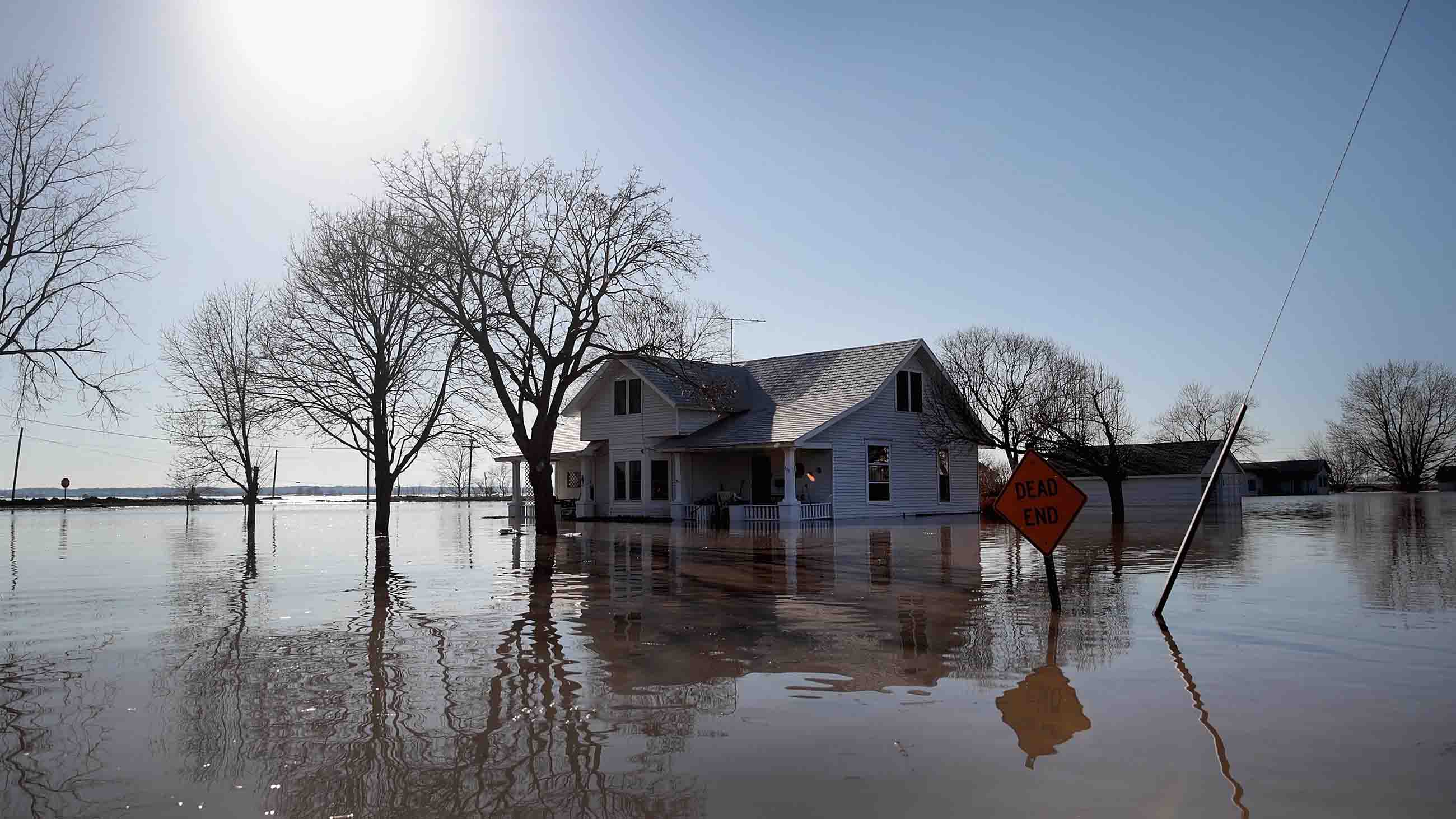
Record flooding devastated many parts of the Midwest and Great Plains this week as heavy rains combined with melting snow to overwhelm a deeply frozen landscape. Even with several deaths and hundreds of millions of dollars in damage, forecasters say the deluge is likely to continue.
In Iowa, as the Missouri River swelled and flowed into towns and fields, Governor Kim Reynolds described the scene in almost Biblical terms. “It looked like an ocean,” she told reporters at the Capitol on Tuesday. Flying over the affected areas, Reynolds described seeing grain silos peeking out of the water — an image illustrative of the flooding’s widespread damage to the country’s agricultural heartland.
In Nebraska, one farmer said 700 of his animals drowned as he tried to move them before the waters rose too high. Many of those that have survived remain stranded, prompting the state’s Army National Guard to air drop hay bales to keep them fed. On Thursday, President Trump approved a request from the state for federal disaster funding.
So far, the Nebraska Department of Agriculture estimated the damage to crops and livestock at more than $800 million, with Governor Pete Rickett calling it “the most widespread disaster we have had in our state’s history.”
After experiencing similarly harsh conditions in 2011, one Iowa farmer estimated that half of the farmers in his area would not be able to recover. Governor Reynolds has issued disaster proclamations for 52 counties in Iowa, while Governor Tony Evers declared a state of emergency for Wisconsin last week. On Thursday, Missouri Governor Mike Parson followed suit.
Though the Army Corps of Engineers, which controls the dams along the Missouri River, tried to prepare for the influx of water, hard decisions had to be made. As the reservoir filled behind the Gavins Point Dam on the border of Nebraska and South Dakota, John Remus, the Corps’ chief of the Missouri River Basin Water Management Division made the call to let the water through to save the dam.
“It’s human nature,” Remus told The New York Times, “to think we are masters of our environment, the lords of creation.” But the system of dams, he said, “was not designed to handle this.”
Also in the news:
• Experiencing flooding of their own, emergency responders in Mozambique, Malawi, and Zimbabwe raced against time this week to rescue thousands of people after Cyclone Idai brought unprecedented devastation to Africa’s east coast. Idai made landfall on March 14 near Beira, Mozambique with sustained winds of over 105 miles per hour and then travelled inland, knocking over bridges, houses, and roads and bringing torrential rain. About 1.7 million people were in the cyclone’s path in Mozambique, while another 920,000 people in Malawi and “thousands more” in Zimbabwe were also affected, said World Food Program spokesperson Herve Verhoosel. Mozambique’s death toll reached 242 yesterday, but President Filipe Nyusi estimated it will climb to 1,000 as crews work to reach remote villages and swollen rivers continue to overflow. United Nations representatives said people in Mozambique were clinging to trees and sitting on roofs awaiting aid, as floodwaters climbed in some areas to 19 feet and more rain is expected. The U.N. announced Tuesday it will allocate $20 million from the Central Emergency Response Fund in response to Idai. (The Guardian)
• The Ebola outbreak that has claimed nearly 600 lives in the Democratic Republic of Congo since last August is likely far from over. Having recently returned from a trip to the embattled Central African country, Robert Redfield, director of the Centers for Disease Control and Prevention, said he saw several troubling signs: Supplies of a key Ebola vaccine seemed to be running low; new cases were turning up in unexpected, unmonitored locations; and a disconcertingly large number of people were contracting the disease at local health clinics. Further complicating matters, violent attacks on treatment centers in northeastern Congo have hindered the efforts of international health organizations and kept CDC employees away from the epicenters of the outbreak. Redfield thinks the epidemic could last another year. Already, it is the second largest Ebola epidemic ever, though it remains far smaller than the outbreak in West Africa that killed more than 11,000 people from 2014 to 2016. (The New York Times)
• The synthetic opioid fentanyl has become a leading driver of drug overdose deaths in the United States, according to a new report from the U.S. Centers for Disease Control and Prevention. Agency statisticians analyzed overdoses from 2011 to 2016 and found a startling spike in fentanyl-related deaths beginning in 2013. Since that time, fentanyl overdose deaths have been doubling every year, according to the analysis; the narcotic is considered between 50 and 100 times more potent than heroin and it kills, primarily, by suppressing respiration. Illicit drug manufacturing businesses in China are now among the foremost producers of illegal heroin sold in the United States. The CDC’s analysis also found that as black market fentanyl becomes more available in American cities, the death rates for African-Americans and Hispanics are climbing faster than any other ethnic group. In the period from 2011 to 2016, fentanyl overdose deaths climbed 141 percent yearly for African-Americans, 118 percent for Hispanics, and 61percent for whites. The report also showed that the majority of the deaths occurred in urban centers east of the Mississippi River. (The Washington Post)
• By late 2018, four women had accused Neil Degrasse Tyson, the popular author, astrophysicist, and TV personality, of sexual misconduct. After launching an investigation into the claims, both Fox and National Geographic — the networks that hosted his shows “StarTalk” and “Cosmos” — announced that he’d be coming back to television without providing any details about what they discovered. The development has left some — including the women that accused Tyson — feeling frustrated at the lack of transparency. Tyson is one of several men accused of sexual misconduct in the #MeToo movement to return to the public eye in recent months, including the comedians Louis C.K. and Aziz Ansari, along with the animator John Lasseter. Tyson’s return has sparked conversation about what investigations of sexual misconduct claims should entail, and how the findings should be communicated to the public. These “investigations are sometimes put forth as a way to resolve sexual misconduct allegations,” writes Anna North for Vox, but “they don’t always feel like a resolution for everyone.” (Vox)
• Few people outside of the scientific and academic publishing worlds will know what “p-hacking” entails, but the practice is both endemic and deeply problematic — enough so that the American Statistical Association felt compelled to devote an entire issue of its quarterly journal, published this week, to the topic. In a nutshell, p-values are a statistical coinage, used to indicate the strength of a study’s findings. The lower the value, the higher the confidence in the results — and many journals reject submissions that fail to meet a certain p-value threshold. With scientists being human, of course, a cottage industry of hacking techniques evolved to goose p-values into respectable territory and increase the odds of a paper’s acceptance. Such practices have become so widespread that they’ve called into question both the utility of p-values at all, and more widely, the veracity of much published science. Among the ASA’s recommendations: Moving beyond sole reliance on p-values as a measure of a study’s significance, and engaging in fuller reporting of outcomes. More methodological transparency prior to commencing experiments could also help, the group suggested. Still, while most researchers acknowledge that p-hacking is a problem, at least one psychologist did not welcome the ASA’s advice: “I don’t think statisticians,” he told Undark, “should be telling researchers what they should do.” (Undark)
• And finally: Two Boeing 737 Max planes involved in fatal crashes in Ethiopia and Indonesia, investigators have discovered, lacked “upgraded” safety features in their cockpits, for which Boeing charged extra and which regulators do not require. While the cause of the crashes is still unknown, authorities suspect that faulty data from sensors on Indonesia’s Lion Air plane, known as MCAS, may have malfunctioned. According to an anonymous source familiar with the situation, Boeing is planning to update the MCAS software, and will also make at least one currently non-standard safety feature, called a disagree light, standard. But another safety feature, known as the angle of attack indicator, is not being considered for standard inclusion. Airline safety experts and pilots that have been interviewed following the recent crashes believe both the disagree light and angle of attack indicator features would have been helpful to the pilots. (The New York Times)










Comments are automatically closed one year after article publication. Archived comments are below.
Fentanyl deaths: At first I was discomfited by “Number of deaths has doubled every year” compared to “fentanyl overdose deaths climbed 141 percent yearly for African-Americans” Wait, I thought, 141 is less than 200%
I fell victim to a common problem with numbers presentations: Change of base, and change of operator. The first statement made me think of the increase as being a *multiplying* factor of the base — previous year’s deaths. The second statement is an *additive* factor. Expressed in common language, I could say, “Fentanyl deaths have increased by 100% compounded each year from 2011 to 2016” or I could say “Among blacks deaths have increase by a factor of 248% per year. Or I could put in a table.